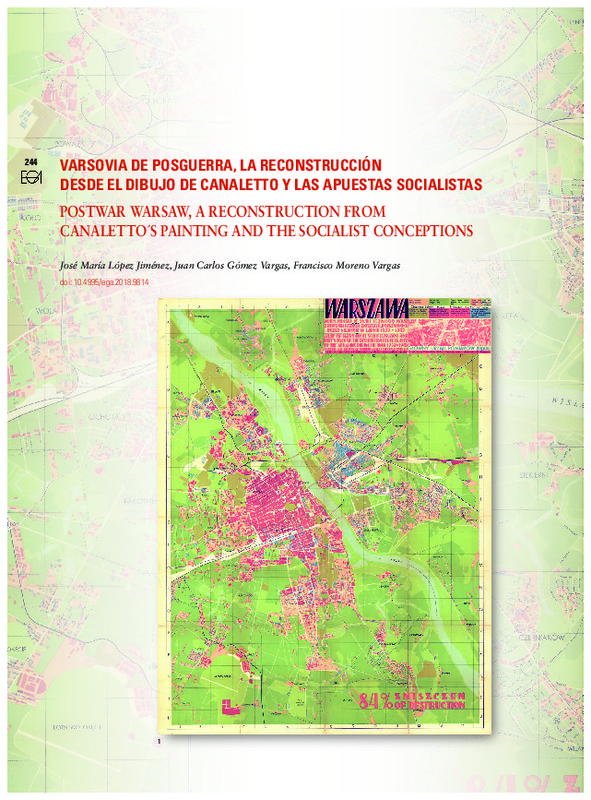JavaScript is disabled for your browser. Some features of this site may not work without it.
Buscar en RiuNet
Listar
Mi cuenta
Estadísticas
Ayuda RiuNet
Admin. UPV
Varsovia de Posguerra, la reconstrucción desde el dibujo de Canaletto y las apuestas socialistas
Mostrar el registro sencillo del ítem
Ficheros en el ítem
| dc.contributor.author | López Jiménez, Jose María
|
es_ES |
| dc.contributor.author | Gómez Vargas, Juan Carlos
|
es_ES |
| dc.contributor.author | Moreno Vargas, Francisco
|
es_ES |
| dc.date.accessioned | 2018-04-04T07:24:40Z | |
| dc.date.available | 2018-04-04T07:24:40Z | |
| dc.date.issued | 2018-03-26 | |
| dc.identifier.issn | 1133-6137 | |
| dc.identifier.uri | http://hdl.handle.net/10251/100006 | |
| dc.description.abstract | [EN] Warsaw, after the strong oppression suffered during the Second World War, conducted a thorough process of urban, social and political restructuring. Since 1944 (with the entry of the Soviet army liberating the city), until 1970, there was a complete restructuring of urban traces. In fact, it could clearly identify the various co-existing ideologies in the new urban plan. This article aims to show how the process envisioned prior to the commencement of the destruction of the city was “drawn” in a revamped urban structure. The regeneration of the city made cohabit with socialist theories conservation concepts or ideas from the modern movement, including urban inquiries emerged in Poland by 1920. From these lines, the graphics redefinition can read these ideological concepts struck in the urban recovery of the stigma caused by the war, conceiving a concept dilute city away from the prewar compact city. | es_ES |
| dc.description.abstract | [ES] Varsovia, tras la fuerte opresión sufrida en la Segunda Guerra Mundial, llevó a cabo un profundo proceso de reestructuración urbana, social y política. Desde 1944 (con la entrada del ejército soviético liberando la ciudad), hasta 1970, se produjo una completa recomposición de las trazas urbanas. De hecho, se pudieron identificar claramente las diversas ideologías coexistentes en el nuevo plan urbano teselando el puzzle urbano. El presente artículo pretende mostrar cómo el proceso de recomposición y reconstrucción urbana se “dibujó” desde las pinturas de Canaletto en el eje histórico de la ciudad. Partiendo del Stare Miasto hasta finalizar en el Palacio Stasic, enlace de Krakowskie Prszdmiescie con Nowy Swiat. La regeneración de la ciudad hizo cohabitar teorías conservacionistas con concepciones socialistas o ideas provenientes del movimiento moderno, y el carácter historicista se fundamentó en los grafismos recuperados tras la guerra. Junto a las trazas dibujadas por los arquitectos en la Posguerra formaron parte del entramado urbano y del sustento constructivo. La definición gráfica otorgada por las pinturas de Canaletto permitió abordar el camino de reconstrucción orientado a reproducir dichas imágenes desde la devastada Varsovia de Posguerra con el objetivo de recuperar la percepción de una capital polaca aún sumida en el estigma social que causó la Segunda Guerra Mundial. | es_ES |
| dc.language | Español | es_ES |
| dc.language | Inglés | es_ES |
| dc.publisher | Universitat Politècnica de València | |
| dc.relation.ispartof | EGA. Revista de Expresión Gráfica Arquitectónica | |
| dc.rights | Reserva de todos los derechos | es_ES |
| dc.subject | Varsovia | es_ES |
| dc.subject | Posguerra | es_ES |
| dc.subject | Movimiento moderno | es_ES |
| dc.subject | Socialismo | es_ES |
| dc.subject | Ciudad histórica | es_ES |
| dc.subject | Definición gráfica | es_ES |
| dc.subject | Warsaw | es_ES |
| dc.subject | Postwar | es_ES |
| dc.subject | Modern movement | es_ES |
| dc.subject | Socialism | es_ES |
| dc.subject | Historical city | es_ES |
| dc.subject | Graphic definition | es_ES |
| dc.title | Varsovia de Posguerra, la reconstrucción desde el dibujo de Canaletto y las apuestas socialistas | es_ES |
| dc.title.alternative | Postwar Warsaw, a reconstruction from Canaletto's painting and the socialist conceptions | es_ES |
| dc.type | Artículo | es_ES |
| dc.date.updated | 2018-03-27T09:44:48Z | |
| dc.identifier.doi | 10.4995/ega.2018.9814 | |
| dc.rights.accessRights | Abierto | es_ES |
| dc.description.bibliographicCitation | López Jiménez, JM.; Gómez Vargas, JC.; Moreno Vargas, F. (2018). Varsovia de Posguerra, la reconstrucción desde el dibujo de Canaletto y las apuestas socialistas. EGA. Revista de Expresión Gráfica Arquitectónica. 23(32):244-253. https://doi.org/10.4995/ega.2018.9814 | es_ES |
| dc.description.accrualMethod | SWORD | es_ES |
| dc.relation.publisherversion | https://doi.org/10.4995/ega.2018.9814 | es_ES |
| dc.description.upvformatpinicio | 244 | es_ES |
| dc.description.upvformatpfin | 253 | es_ES |
| dc.type.version | info:eu-repo/semantics/publishedVersion | es_ES |
| dc.description.volume | 23 | |
| dc.description.issue | 32 | |
| dc.identifier.eissn | 2254-6103 | |
| dc.description.references | Bierut, B., 1950. Szescioletni plan odbudowy Warszawy. Warszawa: Ksiazka i Wiedza. | es_ES |
| dc.description.references | Boscolo, A., 2005. Le trasformazioni urbane di Varsavia nel novecento. Roma: Carocci editore. | es_ES |
| dc.description.references | Gallego, J., 2007. Varsovia, Memoria y Restauración Arquitectonica. Granada: UGR. | es_ES |
| dc.description.references | Królikowski, L.,1997. Warsaw past, present and future = Warszawa wczoraj, dzis, jutro. Warszawa: Akapit. | es_ES |
| dc.description.references | Majewski, P., 2009. Ideologia i konserwacja. Warszawa: Trio. | es_ES |
| dc.description.references | Stepinski, Z.,1988. Siedem placów Warszawy. Warszawa: Panstwowe Wydaw. Naukowe. | es_ES |
| dc.description.references | Zachwatowicz, J., 1958. Comentarios. Kwartalnik Architektury I Urbanistyki Teoria I historia, Tom II Zeszyt I. | es_ES |
| dc.description.references | Zachwatowicz, J., 1971. Architektura perennis. Warszawa: Wydaw Naukowe. | es_ES |
| dc.description.references | Zielinski, J., 1998. Ulica Nowy Swiat. Warszawa: Veda. | es_ES |
| dc.description.references | Zielinski, J., 2009. Realizm socjalistyczny w warszawie. Warszawa: Fundacja Hereditas. | es_ES |








